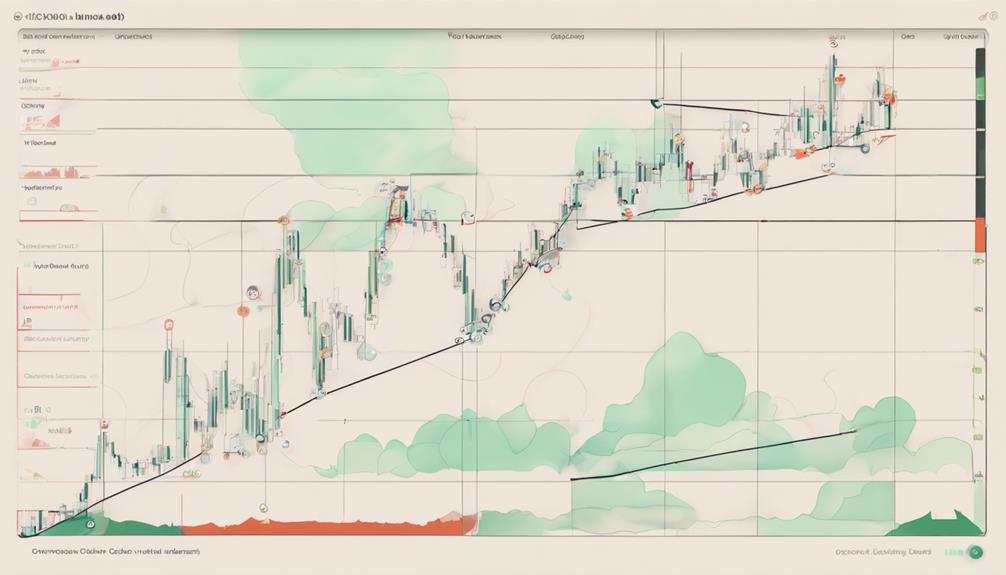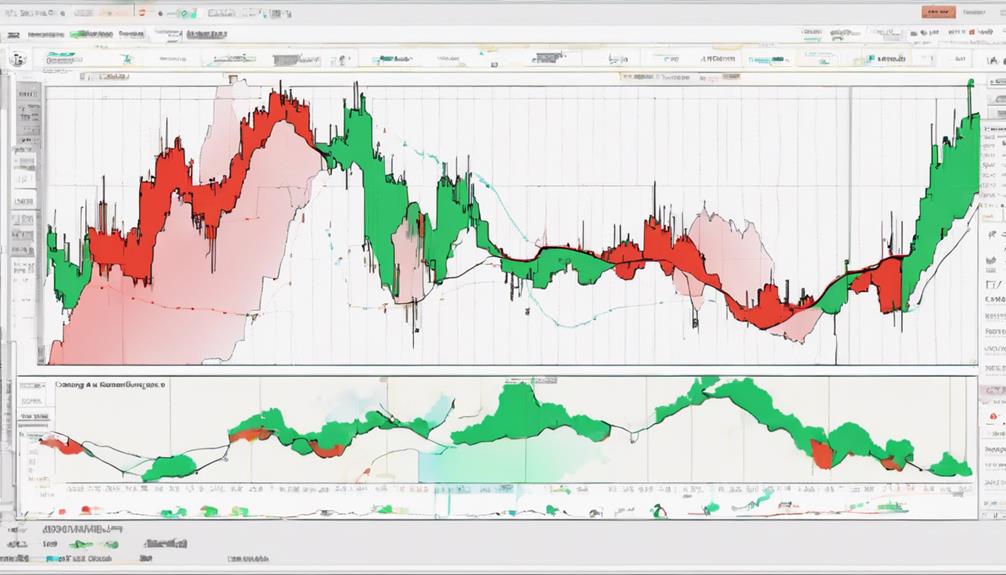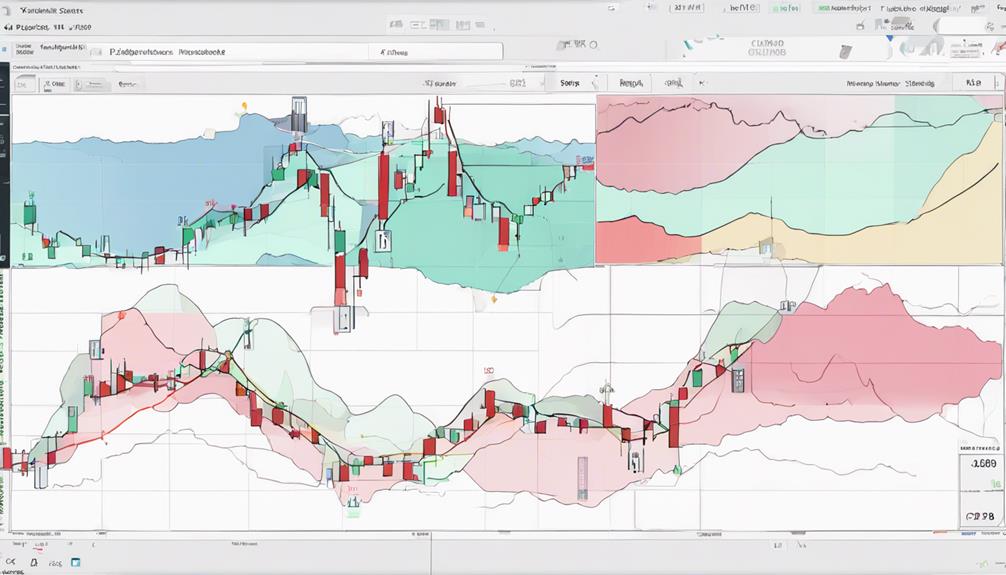If you're navigating the world of technical analysis, understanding the Ichimoku Cloud indicator is like having a compass in a dense forest; it can guide you through the complexities of the market trends.
But, what sets this indicator apart? How does it offer a unique perspective on price movements that traditional tools might miss?
Let's unravel the layers of the Ichimoku Cloud together, and discover how it can potentially enhance your trading strategies in ways you never imagined.
What Is Ichimoku Cloud Indicator?
The Ichimoku Cloud indicator, developed by Goichi Hosoda in the late 1960s, is a comprehensive technical indicator that integrates support, resistance, momentum, and trend direction. This tool goes beyond traditional chart analysis, offering a more thorough assessment of price movements.
One of its unique features is the cloud, which predicts future areas of support or resistance on the chart. By studying the Ichimoku Cloud, traders can gain valuable insights into potential price trends and crucial levels where the market might reverse. It enables traders to interpret trading signals more efficiently, aiding in making informed decisions.
Hosoda's creation has become a staple in technical analysis due to its ability to provide a holistic view of the market dynamics.
Formulas and Key Takeaways

Exploring the formulas and key takeaways of the Ichimoku Cloud indicator provides essential insights for effective technical analysis and informed trading decisions.
The indicator consists of the Conversion Line and Base Line, calculated using the midpoint of the highest high and lowest low over specific periods. Leading Span A and Leading Span B create the colored cloud projection by calculating the difference between these two lines.
This Cloud aspect offers future support and resistance levels, assisting in trend identification and momentum analysis. Understanding these formulas and components is crucial for utilizing the Ichimoku Cloud effectively in analyzing market trends and making well-informed trading choices.
Understanding Cloud Vs. Moving Averages

Contrasting the Ichimoku Cloud with traditional moving averages reveals distinct approaches to analyzing market trends and price movements. The Ichimoku Cloud indicator derives its lines from highs and lows divided by two, providing unique information on support, resistance, and trend direction, unlike moving averages based on closing prices.
While moving averages simplify analysis, the Ichimoku Cloud's five components offer a comprehensive view for traders. It's crucial to validate signals from the Ichimoku Cloud with other technical analysis tools to enhance risk-adjusted returns, a step necessary due to the Cloud's holistic approach.
Utilizing both methods strategically can optimize trading decisions by combining the strengths of each in interpreting market dynamics effectively.
Exploring Senkou Spans and Chikou Span

To further understand market trends and potential trade opportunities utilizing the Ichimoku Cloud indicator, it's essential to examine the calculation and significance of Senkou Spans and Chikou Span.
- Senkou Span A is calculated by averaging the Conversion Line and the Base Line and projecting it 26 periods ahead, providing insight into future support and resistance areas.
- Senkou Span B is determined by averaging the highest high and lowest low over the past 52 periods and projecting it 26 periods into the future, creating a cloud that signifies potential market trend reversals.
- Chikou Span, the closing price plotted 26 periods in the past, assists in confirming potential trade opportunities by analyzing its relationship with the Senkou Spans and the cloud.
Practical Application and Limitations

Understanding the practical application and limitations of the Ichimoku Cloud indicator is essential for traders looking to make informed decisions in the financial markets. This technical analysis tool provides insights into potential support and resistance levels, aiding in identifying entry and exit points.
By analyzing components like the Conversion Line, Kijun Sen, Tenkan Sen, Leading Span B, and Lagging Span, traders can assess price movements and trend strength. However, it's important to note that the Ichimoku Cloud isn't foolproof and should be used in conjunction with other technical indicators for comprehensive analysis.
Traders should be aware of the subjective nature of interpreting the cloud and consider external factors to validate signals accurately.
What Does the Ichimoku Cloud Indicator Show and How Can I Use It in Trading?
The Ichimoku Cloud indicator simplified is a popular tool used in trading to identify trend direction, support and resistance levels, and potential buy or sell signals. It consists of five lines that provide a comprehensive view of the market conditions, making it a valuable resource for traders looking to make informed decisions.
Frequently Asked Questions
How Do You Read Ichimoku Cloud Indicator?
To read the Ichimoku Cloud indicator effectively, you analyze its five components for support, resistance, trend direction, and momentum signals. Price above the cloud signals bullish trend, below for bearish. Use Conversion and Base lines for early signals and trade exits.
What Is the Basic Ichimoku Strategy?
To grasp the basic Ichimoku strategy, focus on using Conversion and Base lines as support and resistance. Identify trend direction by the price's position relative to the Cloud. Buy when above lines for bullish momentum.
What Are the 5 Lines of the Ichimoku Cloud?
The five lines of the Ichimoku Cloud are the Conversion Line, Base Line, Leading Span A, Leading Span B, and Lagging Span. They provide crucial data points by reflecting high and low periods, forming the cloud in the indicator.
What Is the Best Timeframe for Ichimoku?
For the Ichimoku Cloud indicator, the best timeframe depends on your trading style. Active traders may prefer shorter timeframes like 1-hour for frequent signals, while swing traders might find daily or weekly charts more reliable.
Conclusion
You've now mastered the Ichimoku Cloud indicator, a powerful tool in your trading arsenal. With its unique components and formulas, you can navigate market trends with confidence.
Remember, the Ichimoku Cloud isn't just a trend indicator, but a versatile tool for identifying support and resistance levels. Keep honing your skills and combining it with other technical analysis tools for even more insightful trading decisions.
The Ichimoku Cloud is truly a game-changer in the world of trading.
